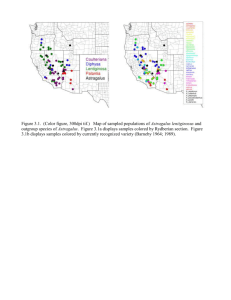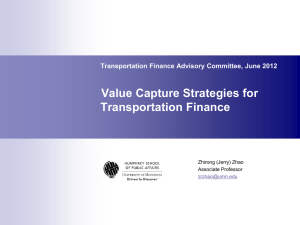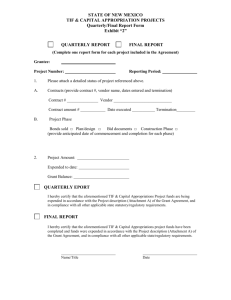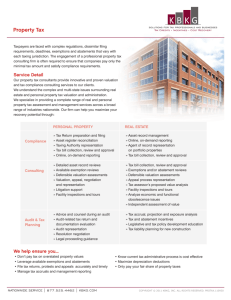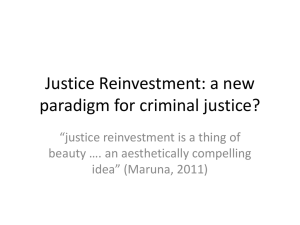Tax Increment Financing - Denton Navarro Rocha Bernal Hyde
advertisement
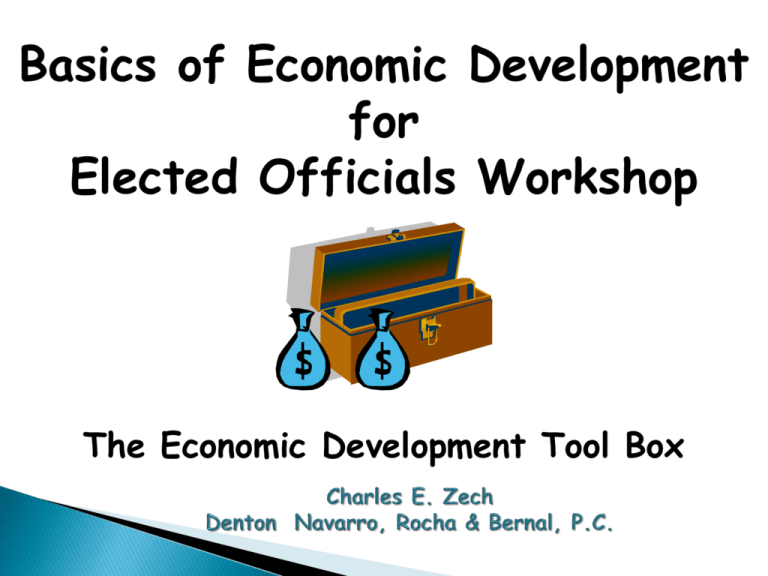
Basics of Economic Development for Elected Officials Workshop The Economic Development Tool Box Economic Development Corporations Municipal Development Districts Public Improvement Districts Neighborhood Empowerment Zones Tax Abatements Tax Increment Financing Development Agreements Industrial District Agreements 380/381 Agreements Economic Development Corporations ED Corporations Type A Sales Tax All cities located in a county with a population of less than 500,000 if the combined local sales tax rate will not exceed 2 percent or the city has a population less than 50,000 and is located within two or more counties one of which is Bexar, Dallas, El Paso, Harris, Hidalgo, Tarrant or Travis Type B Sales Tax All cities if the combined local sales tax rate will not exceed 2 percent ED Corporations Type A Board of Directors City’s governing body appoints at least a five member board Each member appointed to a term not to exceed six years Each member serves at the pleasure of the governing body ED Corporations Type B Board of Directors City’s governing body appoints seven directors Three of the seven cannot be employees, officers or members of the city’s governing body Each member appointed to two year terms Each member serves at the pleasure of the governing body ED Corporations Type A Board of Directors Directors must be residents of city if population is over 20,000 In Cities with population under 20,000 directors must be residents of the county in which the majority of the city is located or reside within 10 miles of the city and in a county which borders the county in which a majority of the city is located ED Corporations Type A Sales Tax Tax is primarily intended for manufacturing and industrial development primary job creation and may be used to acquire or pay for land, buildings equipment, facilities, expenditures, targeted infrastructure and improvements for purposes related to: ED Corporations Type A Sales Tax Manufacturing and industrial facilities Research and development facilities Military Facilities Transportation Facilities Sewage or solid waste disposal facilities Recycling Facilities ED Corporations Type A Sales Tax Air or water pollution control facilities Facilities for furnishing water to the public Small warehouse facilities Regional or national corporate headquarters Primary job training for use by higher education ED Corporations Type A Sales Tax Certain infrastructure improvements that promote or develop new or expanded business enterprises Maintenance and operating costs associated with projects After an election eligible Type B projects ED Corporations Type B Sales Tax Provides cities with a wider range of uses and includes projects for quality of life improvements including economic development that attracts and retains primary employers ED Corporations Type B Sales Tax Revenue may be used for a wide variety of projects including land, buildings, equipment, facilities expenditures and improvements related to Type A primary job creation projects or found by the board to be required or suitable for use for: ED Corporations Type B Sales Tax Professional and amateur sports and athletic facilities; tourism and entertainment facilities; convention and public park purposes and events Related store, restaurant, concession, parking and transportation facilities Related street, water and sewer facilities Affordable housing ED Corporations Type B Sales Tax Projects related to Business Enterprises that Create or Retain Primary Jobs Certain Sports Venue Projects upon an election ED Corporations defined Primary job means: A job that is available at a company for which a majority of the products or services of that company are ultimately exported to regional, statewide, national, or international markets infusing new dollars into the local economy and is included in one several specific NAICS Sectors Local Gov’t Code Chapter 377 Municipal Development Districts Municipal Development District A municipal development district (MDD) sales tax is an optional city sales tax that closely resembles a Type B economic development sales tax. It can be levied within a specified area of the city or its extraterritorial jurisdiction or both. Municipal Development District (a) define the boundaries of the proposed municipal development district (b) call for an election to be held within those boundaries for the creation of the district and the levy of a sales tax at the rate of one-eighth, one-fourth, three-eights, or one-half of one percent Municipal Development District Appoint the MDD Board The board must consist of at least 4 members Directors may be removed by the city council at any time Board members must reside in the city or in the city’s ETJ City council members, city officers, and city employees may be members of the board, but may not have a personal interest in a contact executed by the district. Municipal Development District Establish Development Project Fund. The board must pass a resolution establishing a “development project fund.” It is into this fund that the sales tax proceeds are deposited for expenditure on authorized MDD projects Municipal Development District Type B USES Those uses allowed under TLGC 505.151-501.158 Municipal Development District SPECIFIC MDD USES A convention center facility, or related improvements such as a civic center or auditorium. Parking lots for such convention or related facilities. Civic center hotels. Public Improvement Districts Chapter 372 of the Local Government Code. Public Improvement Districts give municipalities the authority to levy and collect special assessments on property that is within the municipality or within the municipality’s extraterritorial jurisdiction (ETJ). A PID may be formed to accomplish any of the following goals: water, wastewater or drainage improvements Street, sidewalk, Parking and mass transit improvements Library, parks, recreation, art and cultural improvements landscaping and other aesthetic improvements; creation of pedestrian malls other similar improvements The governing body of the municipality initiates or receives a petition Advisory board appointed to develop improvement plan and prepare a feasibility report Public hearing held on the advisability of the improvements Adopt a resolution and begin construction Levy assessments Not property tax but collected like tax and lien subordinate to tax lien – may be deducted like tax. Assessment is a first and prior lien against the property and superior to all other liens except liens for state or local property taxes. Cons Additional tax limited to public improvements PID bonds not marketable – city/county issues the debt Statutory notice and public hearing procedure with annual assessments Pros Deductible if based on value Collected like property taxes Neighborhood Empowerment Zones LGC Section 378.002 allows creation of a NEZ if the creation of the zone would promote the following within the zone: affordable housing (including manufactured housing) an increase in economic development an increase in the quality of social services, education or public safety provided to residents the rehabilitation of affordable housing Adoption of a resolution that contains: determinations required by LGC § 378.002 a description of the boundaries of the zone a finding that the creation of the zone benefits and is for the public purpose of increasing the public health, safety, and welfare of the persons in the municipality a finding that the creation of the zone satisfies the requirement of § 312.202 of the Tax Code (Reinvestment Zones) Upon creation of a NEZ a city is empowered, in addition to other powers, to Waive Building Fees Refund Municipal Sales Taxes Abate Property Taxes Tax Abatements Tax abatements are used by local governmental entities to attract new business and to encourage the retention and development of existing businesses for their area. Chapter 312 of the Texas Tax Code governs tax abatements. Must adopt a resolution indicating intent to participate in tax abatements. General statement of intent to consider providing tax abatements Adopted at an open meeting by a majority vote Home rule cities should look to their Charters for any potential additional requirements. Must adopt tax abatement guidelines and criteria setting out conditions and requirements for eligibility Effective for a period of two years Must provide for the availability of tax abatement to both new facilities and structures and for the expansion or modernization of existing facilities amended or repealed only by a favorable vote of three-fourths of the members of the governing body Must create a reinvestment zone Effective for a period of five years Before creation must find at a public hearing that: the improvements sought are feasible and practical and would be a benefit to the zone after the expiration of the agreement that the zone meets one of the applicable criteria for reinvestment zones Real: apply percentage of abatement to the difference between the value of the real property as of January 1 of the year in which the agreement is executed, and the value of the real property as of January 1 of each year of abatement covered by the agreement. Personal: apply percentage of abatement to the value of the personal property added to the real property subsequent to the execution of the agreement. Local guidelines establish the qualifications, terms under which taxing unit will consider tax abatement, percentage of abatement, and the number of years. Taxing unit adopts resolution stating that it elects to participate in tax abatement. Taxing unit adopts (if not already done) tax abatement guidelines. Guidelines are critical - taxing unit may not enter into agreement unless the terms of the agreement and the property satisfy the guidelines - if project does not satisfy the guidelines the taxing unit will be required to amend the guidelines prior to entering the agreement. Contract Terms: Default termination for breach, bankruptcy, failure to pay impositions with recapture of all or portion of abated taxes, interest and penalties. Performance milestones; minimum taxable values, jobs, sales tax generation, minimum occupancy or presence in the jurisdiction. Design elements or land use controls. TIP: Avoid abatement limitations and process and use Chapter 380/ 381 agreement to provide equivalent of tax abatement. TIP: Follow up abatement agreement with Chapter 380/ 381 agreement to provide equivalent of additional years of abatement. TIP: Abate inventory and to deal with nonFreeport jurisdictions. Tax Increment Financing What is TIF? A legal tool that can be used to finance public improvements TIF can be utilized to promote certain development in targeted areas Authorized by Chap. 311 of Texas Tax Code A Reinvestment Zone must be established by the City and a TIF Fund put in place Reinvestment Zone 35 The City and other taxing entities continue to receive the previously assessed and levied property taxes from within the Zone Reinvestment Zone 35 As property values rise in the Zone with new investment, NEWLY CREATED property taxes will be collected by the entities Reinvestment Zone 35 These incremental property taxes will then be deposited by each entity in a “TIF” Fund” Reinvestment Zone 35 TIF FUND The incremental taxes deposited into the TIF Fund can be used to finance construction of certain public improvements in the Reinvestment Zone. 35 Development of Project plans and designs Acquisition of property for public uses Due Diligence Costs Financing Costs Administrative Costs Site Preparation Utilities Streets & Street Lights Pedestrian Walkways Parks Drainage Facilities Water/Sewer Facilities Educational Facilities Parking Facilities This tool encourages new development in Reinvestment Zones by providing developers with a mechanism to reduce or possibly eliminate public improvement costs associated with their project This reduces the total capital costs Encourages development which would not otherwise occur A Reinvestment Zone must be created to make an area/project eligible for TIF Reinvestment Zone 35 Created by Ordinance Must be contiguous Determination that development or redevelopment would not occur solely through private investment in the reasonably foreseeable future A preliminary reinvestment zone financing plan must be approved before the Zone can be created A public hearing must be held City Council may not create a Reinvestment Zone if more than 10 percent of the property is used for residential purposes Any power necessary and convenient to carry out the requirements of Chapter 311 including: Cause project plans to be prepared and approve and implement the plans; Acquire real property by purchase, condemnation, or other means to implement project plans, and sell that property on the terms and conditions and in the manner it considers advisable; The power of condemnation (eminent domain) is available to a city regardless of the existence of the TIF. Enter into agreements which are necessary or convenient to implement project plans; Acquire , construct reconstruct, or install public works, facilities, or sites or other public improvements, including utilities, streets, street lights, water and sewer facilities, pedestrian malls and walkways, parks, flood and drainage facilities, or parking facilities 5 to 15 members Each taxing entity may appoint one member Two-year appointments. Eligibility: voter of municipality; OR adult owner of real property in Zone Make recommendations to City Council re: Zone administration; Enter into agreements to implement plans; With Council approval, restrict land uses; All powers delegated by City Council; except Issue bonds; Impose taxes or fees; Exercise the power of eminent domain; or Give final approval to the project plan Prepare and adopt: Project Plan, and Reinvestment Zone Financing Plan. • Amendments to the plans can be adopted by the Board at any time However, City Council must approve all plans and amendments thereto Other taxing entities have the OPTION to participate in the reinvestment zone. Other taxing entities determine the amount of tax increment deposited in the TIF fund A taxing unit is not required to pay into the TIF fund unless it enters into an agreement with the City After the Project Plan and agreements with other taxing entities are approved by City Council, participation by other entities cannot change Formula Current Year Value - Base Year Value = Captured Value Captured Value x Tax Rate = Increment The City may issue TIF bonds or notes to pay for project costs. Does not have to issue bonds No other local approval is needed. TIF bonds and notes are payable solely from the TIF Fund. Not General Obligation TIF Bonds are tax-exempt Developers provides up front financing public improvements; THEN In future years, based on triggering proceeds from the TIF Funds will be paid those developers for reimbursement of costs and financing for the events, back to project Pros No Competitive Bidding; Chapter 380 powers. Private sale of real property. Guaranteed stream of revenue or bonds secured by TIRZ funds. Cons Limited to public improvements. Statutory process, limitations, board. Schools won’t participate. Condemnation limited. Types and Authority Types and Authority Development Agreements in the ETJ Developer Participation Agreements Industrial District Agreements Local Government Code Section 212.172 • In writing • Adequate legal description • Approved by Governing Body • Filed in real property records Continuation of ETJ status • No Longer than 15 years Extend planning authority Extend land use and development authority Provide for infrastructure Enforcement of environmental regulations Provide for terms of future annexation • Uses Local Government Code Section 212.071 • Pop. of 5,000 or greater • Public Improvements (NO buildings) • Participate up to 30 % (100% oversize) • Participate up to 70 % (Pop. 1.8 million) • Performance Bond • No Bidding Requirement Local Government Code Section 42.044 • Industrial • Tourist related businesses and facilities Guarantee ETJ status for 15 years And any other lawful terms May provide firefighting services Chapter 380/381 City/county by contract provide incentives consisting of loans and grants of public funds, use of personnel, facilities and services with or without charge for economic development. Provides developer with cash, reimbursement or other consideration. May condition incentive on milestones or other public consideration. Express statutory authority for cities/counties to provide incentives consisting of loans and grants of city funds, use of city personnel, facilities and services with or without charge for economic development. City/county contracts with the recipient of the grant to condition the incentive upon the creation of employment, construction of improvements, certain development, or other public consideration. Determine the amount of cash contribution or waiver of development fees or amount of free services and negotiate a contract with local government. Article III, Section 52-a - constitutional authorization public purpose includes economic development. Unlimited – provided public consideration. Imagination is the limit. Statute and Const. do not specify the kind of incentives. Authorization and not a mechanism. City/county must have guidelines, policies or programs which describe the available economic development incentives and the criteria for eligibility in the same way a city adopts tax abatement guidelines. Program may be general or specific. The incentive agreement may constitute the program. Loans, guaranty, moving/relocation expenses, waiver/ reduction of impact, development, water, sewer or other fees. Grant equivalent of Freeport exemption, tax abatement, sales tax refunds. Fund and/or construct infrastructure, job training, rent subsidies, master leases, tenant deposit guarantee. facilities renovation, residential/commercial Improvement incentive program. City and county may use Chapter 380 & 381 agreements to provide equivalent of tax increment financing – artificial TIRZ without the headaches. Avoid administrative process, statutory restrictions and bureaucracy of a TIF. Create a zone by contract with developer agree to use incremental increase in property tax and/or sales tax from the defined area for contractually defined projects. Allen Village and Event Center - reimbursement for infrastructure for retail shopping center and loan for event center. Pros Imagination is the limit. No maximum term. Cons Voter approval of debt. General revenue funded. Counties unsophisticated. Contract Considerations The Economic Development Tool Box Its full of wrenches Throw ‘em and see who they hit Questions? Charles E. Zech charles.zech@rampage-sa.com Denton, Navarro, Rocha & Bernal P.C. San Antonio: 2517 N. Main Ave San Antonio, TX 78212-3111 (210) 227-3243 Austin: 2500 W. William Cannon Dr., Suite 609 Austin, TX 78745-5257 (512) 279-6431
